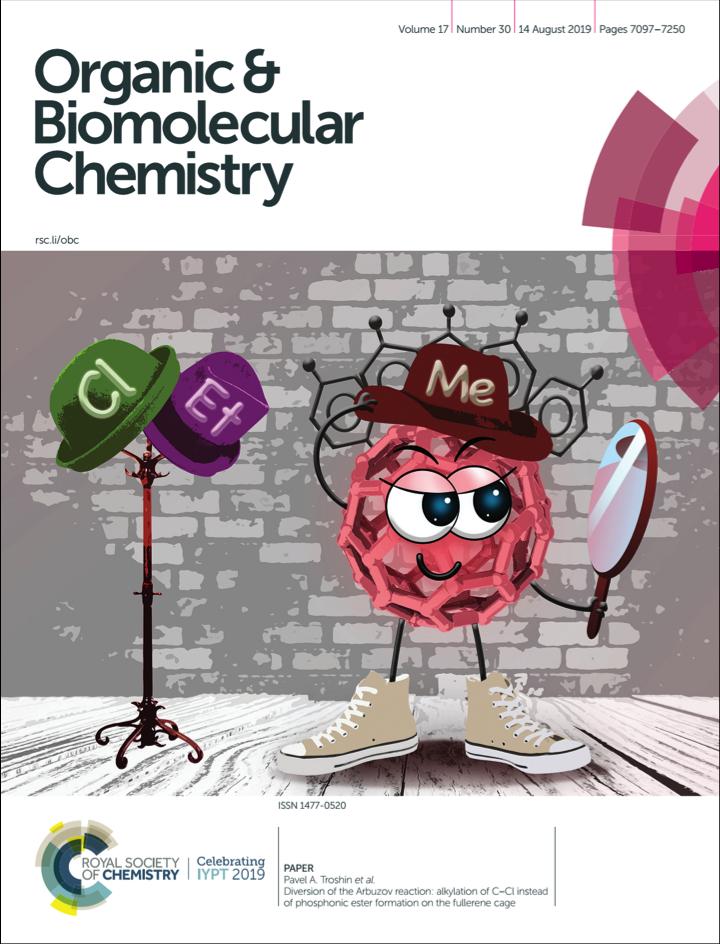
Credit: Organic and Biomolecular Chemistry
Scientists from the Skoltech Center for Energy Science and Technology and the Institute of Problems of Chemical Physics of RAS in collaboration with researchers from four other Russian and foreign research centers have discovered a new reaction that helps obtain water-soluble fullerene derivatives which effectively combat flu viruses, human immunodeficiency virus (HIV), herpes simplex virus (HSV), and cytomegalovirus (CMV).
Viruses have been affecting social advancement over millennia, often causing vast epidemics wiping out entire cities. Viruses attack every living thing on Earth from higher vertebrates to simple, single-cell life forms, bacteria and even other viruses. Currently, over 90% of human infectious diseases are caused by viruses.
HIV that causes AIDS is one of the most dangerous viruses. According to WHO, the number of HIV-infected patients in Russia has already exceeded 1 million (about 1% of the population) and keeps soaring, making an HIV epidemic an ominous threat to the nation.
Global circulation of seasonal flu viruses that kill 500,000 people worldwide every year is yet another critical public health issue. New varieties of flu viruses often entail high mortality rates (up to 60% for H5N1 and H5N8 avian flu) and are highly resistant to existing drugs.
Modern antiviral drugs extend the lifespan and improve the quality of life, while having quite a few major flaws, such as toxicity, limited bioavailability and development of drug resistance. The circulating sets of flu strains change quickly, reducing the efficiency of the commonly administered anti-flu vaccines. All this makes the search for new classes of antiviral drugs a hot-button issue.
A unique form of carbon, C60 fullerene is shaped like a soccer ball with carbon atoms located at the vertices of its pentagons and hexagons. Although fullerene molecules boast unique biological properties, fullerenes and their classical derivatives are insoluble in water and biological media, making their application in medicine extremely difficult.
Two years ago, a research team led by Skoltech Professor, Pavel Troshin, proposed several effective approaches for the synthesis of water-soluble fullerene derivatives. In their latest study, the researchers discovered a unique new reaction that helped obtain a series of previously unavailable water-soluble fullerene derivatives with high antiviral activity. The mechanism of this unusual transformation of fullerenes was proposed based on the quantum chemical calculations.
“Our latest study focuses on the synthesis of highly effective inhibitors of dangerous viral infections, such as HIV, different varieties of flu, HSV and CMV, using fullerene derivatives as a multifunctional platform. We discovered a unique inversed Arbuzov reaction that allows fine-tuning the antiviral properties of new compounds and establishing fundamental correlations between a compound’s structure and antiviral activity,” explains the first author of the paper and Skoltech PhD student, Olga Kraevaya.
The results of this study open up vast opportunities for developing effective antiviral drugs capable of suppressing virus resistant lines, which will help combat currently untreatable infections.
###
The results of the study were published in the journal Organic & Biomolecular Chemistry and announced on its front cover. This study was made available online in May 2019 ahead of final publication in print in August 2019.
Media Contact
Alina Chernova
[email protected]
Related Journal Article
http://dx.




